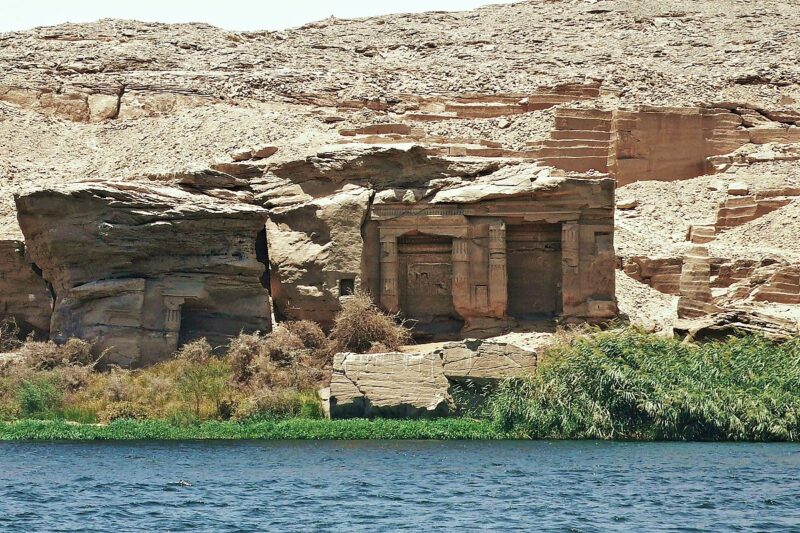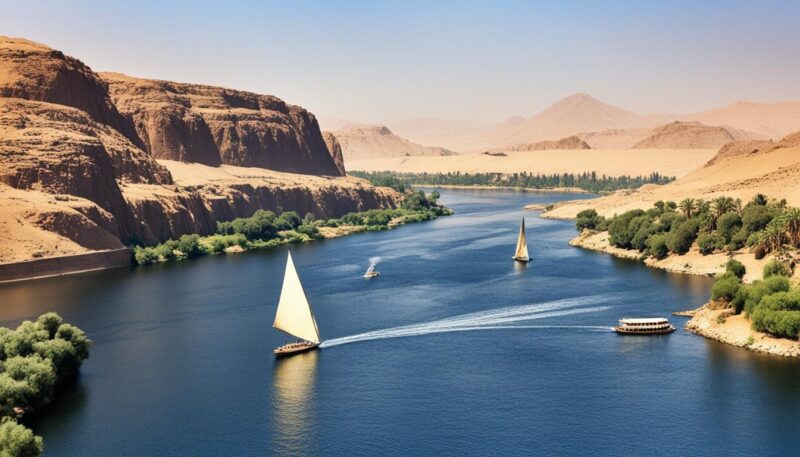The Nile River has long been a symbol of life, history, and cultural richness. For those ready to go beyond mainstream stops like Luxor and Aswan, the river hides lesser-known marvels waiting to be explored.
These sites provide intimate glimpses into Egypt’s past and its people, promising an unforgettable adventure away from the crowds.
1. Set Sail in Style ─ Nile Cruise

For an unforgettable journey, try luxury Nile Cruise aboard the Princess Farida Dahabiya. This boutique-style cruise offers travelers an exclusive view of Egypt’s most iconic landmarks. The tranquil pace lets you absorb the serene beauty of the river while relaxing in luxurious suites. It’s a perfect blend of exploration and indulgence, ideal for travelers seeking an elevated experience.
Passengers often praise the Dahabiya for its intimate ambiance, far from the hustle of larger vessels. Personalized service and thoughtfully curated itineraries allow you to visit hidden sites, ensuring your journey feels tailored and special.
2. Esna ─ More Than Just a Market Town
Esna, a modest town often overshadowed by larger destinations, has its own charm for those willing to stop and explore. The Temple of Khnum, partially buried beneath modern structures, offers a fascinating peek into Egypt’s Ptolemaic period. Its vivid carvings and intricate columns feel almost alive, a testament to ancient artistry.
Beyond its historical allure, Esna’s vibrant market buzzes with local flavor. Vendors sell everything from handwoven textiles to fragrant spices, making it an ideal spot for those seeking unique souvenirs. Enjoying a cup of sweet tea at a street-side café while watching daily life unfold is a simple yet memorable experience.
Traveler tips:
- Arrive early to appreciate the temple without interruptions.
- Bargain politely but firmly in the market to secure fair prices.
3. Gebel el-Silsila ─ Egypt’s Quarry of Giants

Few visitors think of ancient stone quarries as must-see sites, but Gebel el-Silsila breaks the mold. Located between Edfu and Kom Ombo, this site was the backbone of ancient Egyptian architecture. Sandstone blocks from here built monumental sites like Karnak and Luxor.
Walking through the quarries reveals inscriptions left by workers centuries ago, offering rare insight into their daily lives. Unlike crowded temples, Gebel el-Silsila lets you immerse yourself in quiet reflection, surrounded by cliffs that whisper tales of toil and triumph. For history lovers, it’s a poignant reminder of the human effort behind Egypt’s grandeur.
4. Kom Ombo ─ Two Temples, One Unique Perspective
Kom Ombo’s twin temples set it apart from every other site in Egypt. Devoted to Sobek, the crocodile god, and Horus, the falcon deity, its symmetrical design feels almost modern. The riverside setting adds to its appeal, especially at sunset when the golden light bathes the temple in warmth.
A small museum nearby houses mummified crocodiles, a quirky yet fascinating feature that underscores the Egyptians’ reverence for the Nile and its creatures. Visiting Kom Ombo gives you a deeper appreciation for the interconnectedness of ancient belief systems and their environment.
5. Edfu ─ Horus’s Temple of Triumph
The Temple of Horus in Edfu is one of Egypt’s best-preserved ancient structures. Walking through its towering gateways, you’ll feel the weight of history. Every wall, hall, and pylon teems with hieroglyphics and carvings depicting battles, ceremonies, and mythology.
Arriving at Edfu by horse-drawn carriage adds an old-world charm to the experience. Local guides bring the temple to life, narrating tales of Horus’s victory over Seth. It’s a site that combines beauty with storytelling, making it a favorite among travelers seeking both history and inspiration.
6. Nubian Villages ─ A Burst of Color and Culture
Tucked along the riverbanks near Aswan, Nubian villages stand out with their brightly painted homes and warm hospitality. A visit here offers an immersive cultural experience far from typical tourist attractions. Locals often invite visitors into their homes for tea, a gesture of hospitality that reveals their vibrant way of life.
Markets in Nubian villages are perfect for finding handmade jewelry, colorful fabrics, and artisanal crafts. The community’s deep connection to the Nile is evident in their stories, songs, and cuisine. Spending time here not only enriches your trip but also supports local economies.
Pro Tip: Respect local customs by dressing modestly and seeking permission before taking photos.
7. Philae Temple ─ A Sanctuary of Serenity
Philae Temple, dedicated to the goddess Isis, is an island treasure steeped in mystery and beauty. Accessible only by boat, the journey itself sets the tone for an intimate exploration. The temple’s relocation during the construction of the Aswan High Dam is a marvel of modern engineering, preserving its ancient splendor for future generations.
Visiting at sunrise or sunset enhances the magic, as the soft light adds an ethereal quality to the experience. The island setting, surrounded by calm waters, creates a sense of peace, making Philae one of the most spiritual places along the river.
8. Elephantine Island ─ A Blend of Past and Present
Elephantine Island combines ancient ruins with the lively culture of modern Nubian communities. As the southernmost settlement in ancient Egypt, it played a key role in trade and defense. Today, visitors can explore its archaeological sites, including the Temple of Khnum and the Nilometer, an ancient device for measuring river levels.
The island also offers vibrant cultural experiences, with Nubian homes, schools, and art centers showcasing the community’s enduring heritage. Spending time here feels like stepping between two worlds, where history and modernity coexist seamlessly.
9. Lake Nasser ─ A Hidden Oasis
For travelers who crave solitude, Lake Nasser is a sanctuary of serenity. Stretching south of Aswan, it offers stunning desert landscapes and an unspoiled environment. Boat trips on the lake reveal hidden temples like Kalabsha and Wadi es-Sebua, often visited by only a handful of people each day.
The highlight is Abu Simbel, a UNESCO World Heritage site carved into cliffs overlooking the lake. Its colossal statues of Ramses II leave an indelible impression. Exploring Lake Nasser feels like venturing into uncharted territory, where nature and history intertwine beautifully.
10. Dahshur ─ The Quiet Side of Egypt’s Pyramids
Dahshur offers a refreshing alternative to the crowds at Giza. Home to the Bent Pyramid and Red Pyramid, it’s an ideal stop for those seeking to connect with Egypt’s ancient history in peace. The unique shape of the Bent Pyramid, with its abrupt angle change, reflects early attempts at perfecting pyramid construction.
The Red Pyramid, named for the reddish hue of its limestone, allows visitors to climb inside and experience its cavernous chambers. The lack of commercialization at Dahshur enhances its allure, offering a raw and unfiltered glimpse into Egypt’s ancient engineering prowess.
Seasonal Tips for Your Journey
The timing of your trip significantly impacts your experience. Winter, from November to February, is ideal for those who prefer cooler weather and lighter crowds. Spring brings lush landscapes and a sense of renewal, while summer offers budget-friendly deals for those willing to brave the heat.
Travelers should pack lightweight clothing, comfortable walking shoes, and plenty of sunscreen. A reusable water bottle and local currency for tips are also essential. Planning your itinerary around Egypt’s major festivals can add cultural depth to your journey.

Experiencing Authenticity Along the Nile
Exploring beyond mainstream sites enriches your journey with unique stories, connections, and moments of discovery. Whether you’re walking through a Nubian village, admiring ancient inscriptions at Gebel el-Silsila, or marveling at the ingenuity of Dahshur’s pyramids, the river reveals itself as more than a lifeline.
Hidden gems along the Nile embody the spirit of adventure, where history, culture, and natural beauty converge. By venturing off the beaten path, you create a personalized narrative that stays with you long after the trip ends.








